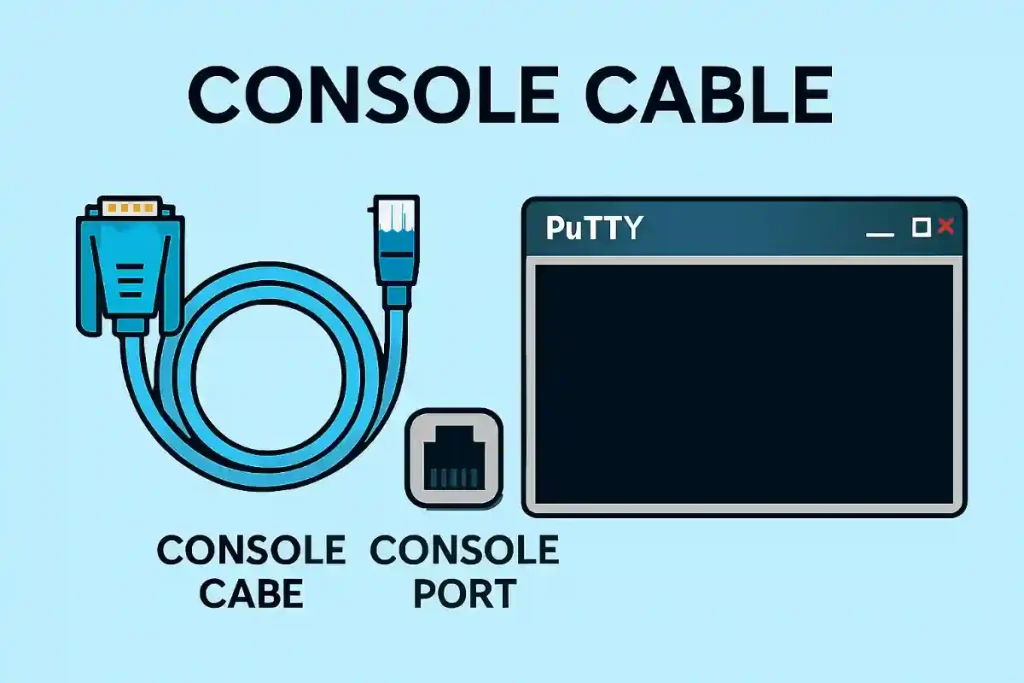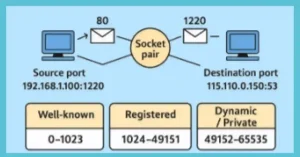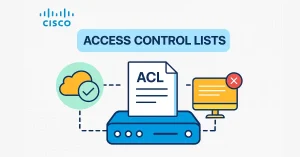Console Access is an essential topic for networking students, so I will explain console access to Cisco devices in this lesson. All Cisco routers and switches have a console port, the management interface. It connects a computer directly to a router or switch and manages it. The console port is also used for initial configuration.
Console Port and Cable Overview
All Cisco routers and switches feature a console port, typically an RJ-45 port, used for direct management and initial configuration. A rollover cable connects the computer’s serial or USB port to the device’s console port, with options including RJ-45 to DB9 and RJ-45 to RJ-45 cables.
Cable Types
- Rollover Cable (RJ-45 to DB9): Used with computers having a serial port.
- USB-to-RS-232 Adapter: Required for modern computers without serial ports, paired with a rollover cable.
- USB Type-A to Type-B Cable: Supported by Cisco ISR G2 routers for USB console access, requiring a specific driver from www.cisco.com.
Connection Notes
- Only one console port (RJ-45 or USB) is active at a time on ISR G2 routers.
- Connect the Type-A end to the computer and the Type-B end to the router for USB setups.
Typically, the router console port is an RJ45 port. A Rollover cable is used to connect the Serial/COM port of the computer to the router or switch console port. It has to type RJ-45 to DB9 Console access cable and RJ-45 to RJ-45 Console access cable.
Terminal Software for Console Access
Terminal software is also required to access the router and switches. The Tera Term, Putty, and Hyper Terminal are usually used to access the router and switches on a console port. Most People use Putty software for console access. The figure below shows the terminal window of PuTTY.
Setup Steps
- Download and install PuTTY from www.putty.org.
- Connect the rollover or USB cable to the computer and Cisco device.
- Open PuTTY, select Serial connection type, and enter the COM port (e.g., COM1) detected in Device Manager.
- Set baud rate to 9600, data bits to 8, parity to none, stop bits to 1, and flow control to none.
- Click Open to access the console (see Figure below for PuTTY terminal).
Figure Description
- Figure: PuTTY terminal window showing a serial connection to a Cisco device, with a command prompt (e.g., Router>).

The cable connects the host’s serial port to the device’s console port. Most computers and notebooks now lack built-in serial ports.
The USB port can establish a console access connection if the host uses a computer without a serial port. For this purpose, a USB-to-RS-232 compatible serial port adapter is required when using the USB port.
The Cisco Integrated Service Router G2 supports a USB connection. It should use a USB Type-A to USB Type-B cable and an operating system device driver.
The driver for this type of cable is available from www.cisco.com. These routers use two console ports; only one can be active simultaneously. When someone connects the USB cable to the USB console port, the RJ-45 console port becomes inactive.
If the USB cable is not plugged into the USB port, the RJ-45 port becomes active. When connecting the USB cable, the Type-A side should be connected to the computer side, and the Type-B side should be connected to the outer side.
Troubleshooting Console Access
Console access issues can hinder device management. Use these steps to diagnose and resolve problems.
Common Issues and Solutions
- No Connection:
- Action: Verify cable type and connections; check the COM port in Device Manager or reinstall the USB driver from www.cisco.com.
- Garbled Output:
- Action: Ensure baud rate matches (default 9600); reset PuTTY settings and reconnect.
- Inactive Port:
- Action: Confirm that only one console port (RJ-45 or USB) is in use on ISR G2 routers; disconnect the other cable.
Verification
- Use the show version after connection to confirm device access.
Conclusion
Console access is a foundational skill for CCNA and CCNP students, enabling direct Cisco device management and configuration. This article has covered cable types, terminal software, and troubleshooting tips, with a focus on modern USB setups. Practice these techniques in Packet Tracer or real labs to excel in exams and network administration.
Frequently Asked Questions (FAQs)
What is a console port on a Cisco device?
A console port is an RJ-45 or USB port on Cisco routers and switches for direct management. It’s used for initial configuration and troubleshooting. CCNA students must master its setup for exams.
How do I connect to a Cisco device using USB?
Use a USB Type-A to Type-B cable with a Cisco ISR G2 router, installing the driver from www.cisco.com. Connect Type-A to the computer and Type-B to the device. Only one port (USB or RJ-45) is active at a time.
Why is my console connection not working?
A failed connection may result from a wrong COM port, incorrect baud rate, or loose cable. Check Device Manager for the port and reinstall the driver if using USB. Verify settings in PuTTY.
What terminal software should I use for console access?
PuTTY is the most popular choice due to its ease of use and wide support. Alternatives include Tera Term and HyperTerminal. Download from www.putty.org and configure serial settings correctly.
Can I use console access remotely?
Console access is typically local, but remote access can be achieved via SSH or Telnet after initial setup. This is a CCNP-level topic requiring network configuration. Use console for initial device access.





